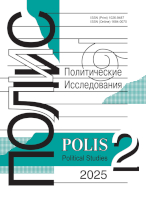The Phenomenon of Constituency Boundaries Commissions:
Development and Prospects
Grishin N.V.,
Professor, Astrakhan State University, nvgrishin@mail.ru
elibrary_id: 304223 | ORCID: 0000-0002-0850-7581 | RESEARCHER_ID: AAH-4130-2020
DOI: 10.17976/jpps/2018.04.08
Grishin N.V. The Phenomenon of Constituency Boundaries Commissions: Development and Prospects. – Polis. Political Studies. 2018. No. 4. https://doi.org/10.17976/jpps/2018.04.08
The modern political science concentrates on case studies of constituencies’ boundary commission. Less attention has been paid to theoretical or even complex descriptive study of the phenomenon. To fill this gap, the present paper advances the first analysis of the institution of constituencies’ boundary commission. This paper argues that these commissions are a unique institution regarding the method of forming, position in the system of governance, and the mode of operation. They solve specific administrative and political tasks in redistricting process, which cannot be performed by election commissions or other bodies. The institute of boundary commission is the only known mechanism to ensure the full participation of experts in the delimitation process. The commission is to ensure transparency in the delimitation process, public participation and political representation at a highest level. The presence of a constituencies’ boundary commission corresponds to a high stage of development and institutionalization of the redistricting process. At the present stage the institute of boundary commission has become especially widespread in countries with the governmental model of electoral management. Another prerequisite for the implementation of these commissions is electoral system with the single member districts. The empirical relevance of the findings is tested making cross-case generalizations in 25 countries. It is conceivable that there are no institutional obstacles to implementing the constituencies’ boundary commissions in the countries with “strong” election commissions.
References
Code of Good Practice in Electoral Matters, Guidelines and Explanatory Report. European Commission for Democracy through Law. 2002. 33 p.
Courtney J. Electoral Boundary Redistributions: Contrasting Approaches to Parliamentary Representation. – Comparative Political Studies: Australia and Canada. Ed. by M. Alexander, B. Galligan. Melbourne: Longman Cheshire. 1992. P. 45-58.
Good Commonwealth Electoral Practice. London: Commonwealth Secretariat. 1997. 16 p.
Gosudarstvennaja jelektoral’naja politika v Rossii: vzgljad jekspertnogo soobshhestva [State Electoral Policy in Russia: a View of the Expert Community]. Ed. by N. Grishin. Astrakhan: R.V. Sorokin. 32 p. (In Russ.)
Grishin N. The Institutionalization of the State Electoral Policy. – Political Expertise Journal. 2015. No. 1. P. 89-107. (In Russ.)
Grishin N., Marmilova E. The Methodological Turn in Contemporary Studies of Public Policy and Management in the Electoral Process. – Modern Science and Innovation. 2015. No. 4. P. 41-49. (In Russ.)
Handley L. Boundary Delimitation. – Challenging the Norms and Standards of Election Administration. Washington D.C.: IFES. 2007. P. 59-74.
Handley L. et al. Delimitation Equity Project Resource Guide. Center for Transitional and Post-Conflict Governance at IFES and USAID publication. 2006. 406 p.
Johnston R., Rossiter D., Pattie C. The Boundary Commissions: Redrawing the UK’s Map of Parliamentary Constituencies. Manchester: University Press. 1999. 444 p.
McRobie A. Defining Electoral Districts: Three Essays on Electoral Redistribution. Christchurch: MC Enterprises. 1990. 63 p.
Morozova O.S. Formation of Constituencies as a Method of Electoral Targeting. – Kaspijskij region: politika, jekonomika, kul’tura. 2013. No. 1. P. 106-112. (In Russ.)
Norris P. Why Elections Fail. NY: Cambridge University Press. 2015. 264 p. https://doi.org/10.1017/ CBO9781107280908
Redistricting in Comparative Perspective. Ed. by L. Handley and B. Grofman. Oxford: Oxford University Press. 2008. 331 p.
Smith J., Landes R. Entitlement Versus Variance Models in the Determination of Canadian Electoral Boundaries. – International Journal of Canadian Studies. 1998. Spring. P. 19-36.
See also:
Shaparov A.Ye.,
The granting of suffrage to aliens: tendencies and practices. – Polis. Political Studies. 2011. No1
Barsukova S.Yu., Denisova-Schmidt E.V.,
Political “Investments” by Businesses in Russia, or Why Does Business Finance Election Campaigns?. – Polis. Political Studies. 2020. No3
Buzin A.Yu.,
Russian electoral indices evolution in 1996-2012. – Polis. Political Studies. 2014. No6
Merloe P.,
Electoral Campaigns and Pre-Election Issues: The Level Playing-Field and Democratic Elections. – Polis. Political Studies. 1995. No4
Korgunyuk Yu.G.,
Electoral Corruption. Medical Record. – Polis. Political Studies. 2015. No2





.jpg)






 print
print
.jpg)
.jpg)